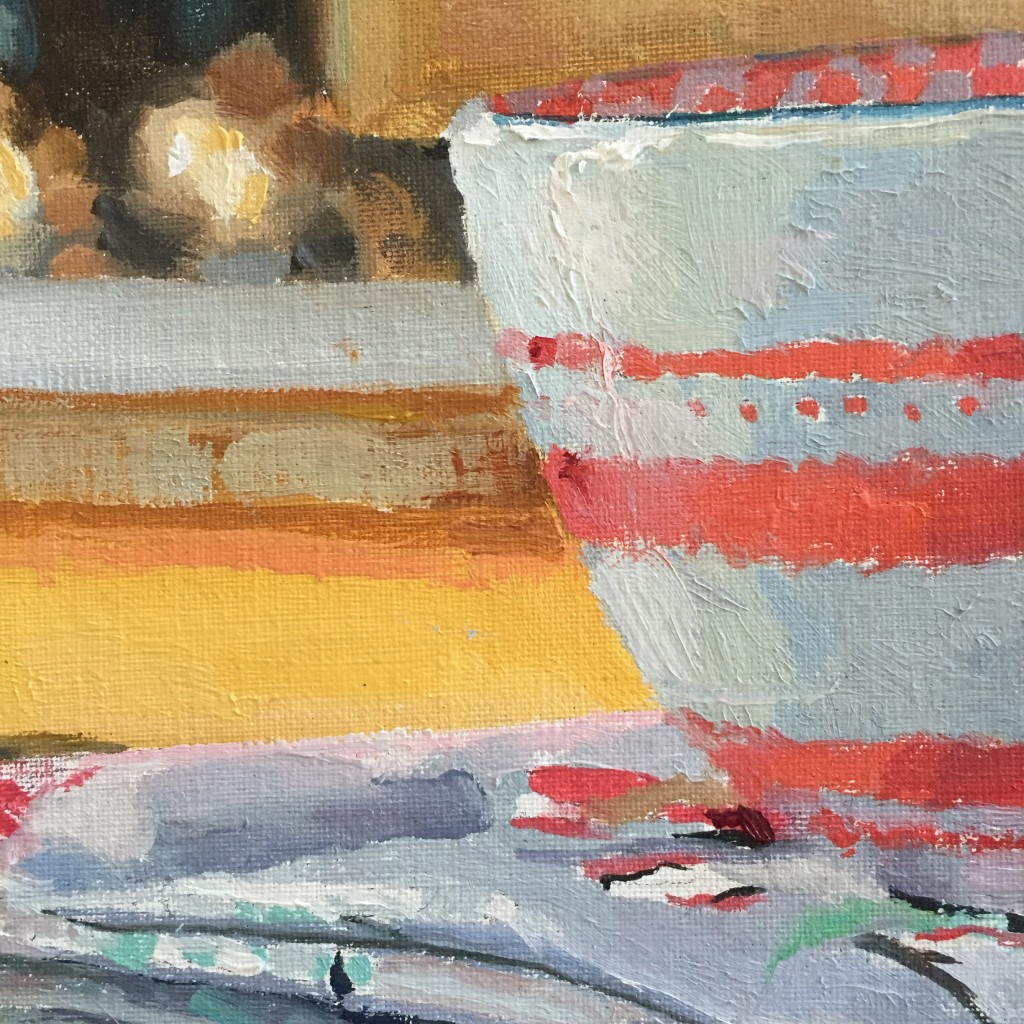Freedom and obedience
I’ve gotten back to a schedule of daily painting, and it makes a difference. When you get pulled away from painting for periods of time, it takes awhile to regain momentum and also to restore a sense of confidence in balancing the freedom of making intuitive, felt choices—taking chances to see what will happen—against an adherence to predictable craft, what you know paint will do from years of working with it. Which is obedience: to what you see, and what you know you need to do. If you go too far toward freedom, or you surrender completely to a routine of reliable labor, the soul of the painting slips away, or else it just becomes a mess.
So far, since I’ve been able to resume working every day, I’ve stuck to a series of smaller paintings of patterned bowls in order to focus more on the surface and the paint, less on producing an exact replica of what I see. I’m giving myself more room to improvise with color, and the way I’m setting up each still life it’s easier for me to see the flat pattern of shapes and color in an abstract way. I’m trying to increase the tension between representation and visible marks. I told Bill Santelli recently that I’m attempting to use a thicker application of paint, but afterward I realized that wasn’t entirely right: in places I’m letting bits of canvas show through, so the paint’s actually non-existent in those spots—one can’t get any thinner than that. But when I’m applying the paint, more often its consistency is closer to its original viscosity out of the tube. It’s thick where it needs to be and thin where it needs to be, that’s all, but overall a little heavier than in the past. I want the paint to be visible, as paint, as much as possible. I’m also trying to simplify the areas of color, and value, striving for the ability to depict more with less brushwork, while leaving more evidence of my hand and the brush. I’ve done all of these things in the past, intermittently, and then returned to the more finished, highly detailed realism of most work I usually sell. (I plan to alternate between both modes now.) Paintings I’ve done this way have sold, as well, so marketability isn’t the calculation I’m making. In this series, I want paintings that evoke more while specifying less, that’s all. And if I succeed, I may be able to apply what I’m learning in more and more ways.
When I was in Manhattan to see Suzie MacMurray’s show, I put in a day touring a dozen other galleries, and saw Alyssa Monks’ new paintings at Forum. She seems to be trying to break away from the photorealism she’s been known for—and it’s giving her a path toward a much more varied palette, looser application of paint, and images that are much less about the way the physical world looks and seem closer to a psychological depiction of an inner world. It’s a move away from the urge to astonish with technical skill toward something more felt and elusive and hard to pin down. Still, I wanted them to be even more abstract, looser and ambiguous—in reality they may simply be straightforward depictions of a beautiful face seen through a window that reflects a wooded tract behind the viewer. (A new take on her faces seen through water, only this time the water is still and reflective.) But her focus on color and the more painterly technique seems as if it might lead to something even more interesting. And I learned Arcadia, one of my favorite galleries, has moved to Santa Monica. I was disappointed not to be able to pay a visit, but it’s now located on the same street where my son and daughter-in-law live–which will be mighty convenient in July.

Comments are currently closed.